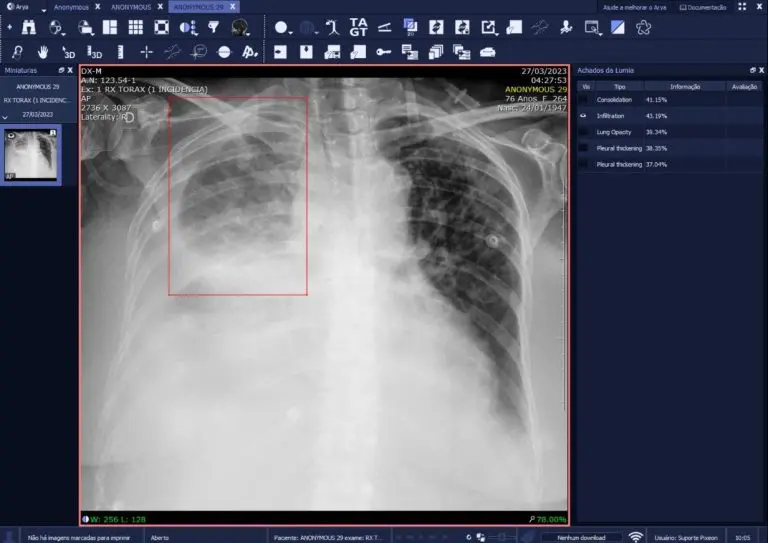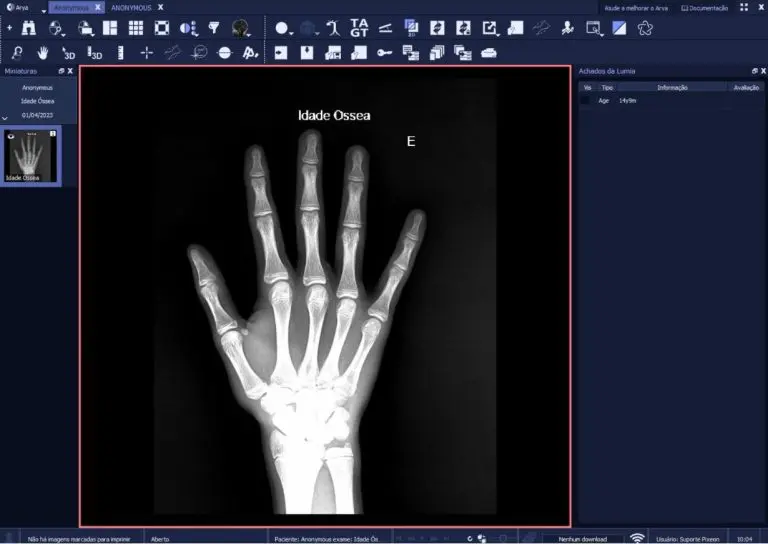AI for radiology is now a reality. It is well known that Artificial Intelligence (AI) is a powerful ally in the challenge of increasing business productivity. According to PwC's Global Artificial Intelligence Study, this technology is expected to boost global GDP by $15.7 trillion by 2030.
The healthcare sector is one of the most benefited by artificial intelligence. AI brings advantages to institutions, doctors, and patients alike.
Its use is particularly advantageous in radiology and diagnostic imaging clinics, which handle a large volume of exam requests and reports. Its application is gradually becoming a prerequisite for imaging diagnostic centers (CDIs) that aim to provide 5.0 healthcare services.
In this article, you will understand the role of AI in diagnostic medicine and learn about some examples of AI for radiology.
The Role of AI in Radiology and Diagnostic Imaging
The main goal of artificial intelligence applications is to improve and assist human activities, not replace people.
Therefore, the radiologist’s work is not eliminated but enhanced. After all, a radiological diagnosis cannot be made based solely on images.
Regardless of the specialty, a doctor needs to evaluate different aspects before issuing a report, such as the patient’s history, symptoms, existing pathologies, genetic and family predispositions, mental health, and even socioeconomic and environmental factors.
AI tools cannot provide or sign off on diagnoses, but they can support professionals in recognizing and differentiating images by suggesting clinical findings.
Thus, the radiologist must assume professional and ethical responsibility for the report, even with this assistance. Some areas benefit more from technological advancements.
This is the case for complex exams such as computed tomography (CT), magnetic resonance imaging (MRI), and nuclear imaging. The same applies to difficult-to-diagnose organs such as the lungs, breasts, and brain, as well as specialties like mastology and oncology.
Download now >> [E-book] Healthcare 5.0: Advantages, Applications, and Essential Technologies.
How Does Technology Support Radiologists?
With AI, radiologists are expected to improve time management by reducing manual tasks, especially those related to quantification.
Thus, professionals can spend more time analyzing images and patient history while spending less time on operational activities.
For example, in the past, detecting coronary arteries required manual segmentation. Today, software performs this task: it segments, characterizes atherosclerotic plaques, and even assists in grading stenosis.
Additionally, AI helps enhance productivity and work quality for professionals in medical institutions.
Some AI algorithms can quantify just as well or even better than the radiologist. The variability in measurements made by algorithms tends to be lower, ensuring greater precision.
Main Advantages of Using Artificial Intelligence Solutions in Radiology and Diagnostic Imaging
AI tools have been present in radiology for quite some time, including applications such as bone densitometry analysis, voice recognition for report generation, and automatic segmentation of coronary arteries.
Significant advances were achieved with their implementation, and they have now become so routine that they go unnoticed.
The most modern AI tools, with a significant impact on radiology productivity, are still in the validation phase. Some benefits include:
- Increased productivity and better radiology management: By eliminating operational tasks, AI allows radiologists to save time and analyze more exams without losing diagnostic precision.
- Faster diagnosis of urgent cases: AI assists in prioritizing critical findings and prevents the progression of severe illnesses. An example is pulmonary thromboembolism and intracranial bleeding, where the tool automatically alerts the radiologist.
- Greater diagnostic reliability: The image databases used in these tools are frequently updated and contain a significantly larger number of images than radiology books and manuals, increasing result reliability.
AI Applications for Radiology
The development of AI solutions is based on different techniques and concepts, such as computer vision and deep learning, a method based on artificial neural networks that simulates human brain behavior at a more advanced level.
Today, AI-powered radiology software can already identify unusual characteristics in medical images, suggesting possible clinical findings that need evaluation by the radiologist.
In practice, these innovations create an advanced image recognition capability by processing large, continuously updated databases.
Here are some current applications:
AI Helps Detect Rare Cases and Disease Risks
Certain pathologies are difficult to detect, as is assessing a person’s risk of developing a particular disease. AI solutions feature capabilities that assist doctors in detecting rare cases and specific characteristics.
Moreover, when possible diagnoses involve highly similar images or extreme variability, AI provides professionals with more confidence in issuing reports.
Cardiovascular Disease Risk Detected Through Retinal Analysis
In 2018, Google Brain, Google’s artificial intelligence research division, developed an ocular scanning program with a specific algorithm to identify retinal data used to detect cardiovascular disease risks, such as age, sex, smoking habits, and systolic blood pressure.
According to data released by the organization, the tool recorded a 70% success rate in tests of images of real people who could have a heart attack or stroke in the next five years.
Currently, retinal analysis is performed only by ophthalmologists. With improved AI tools and applications, this method could become more accessible and practical.
For example, an institution with a retinoscope but no specialist to interpret images—especially for normality triage—could benefit from AI integration.
AI for Radiology in PACS Pixeon Aurora
At Pixeon, AI-powered features are already integrated into the Pixeon Arya diagnostic viewer, which is part of PACS Pixeon Aurora. This provides radiologists with faster reporting, higher diagnostic accuracy, and increased productivity.
Here are some of these features:
AI for Mammography
Breast cancer analysis involves inspecting mammograms to detect lesions and tumors.
The AI in PACS Pixeon Aurora automatically segments the breast mass, continuously evolving mammography analysis, and suggests mammary findings with density classification and lesion malignancy grading (BiRads). This feature can also assist in triage, prioritizing treatment.

AI for Pulmonary X-Rays
Pneumonia is a lung infection responsible for over 600,000 hospitalizations annually in Brazil’s Unified Health System (SUS).
Diagnosing pneumonia in a chest X-ray requires specialized professionals who cross-reference clinical history, vital signs, and laboratory tests.
In PACS Pixeon Aurora, machine learning algorithms detect lung opacity spots (pleural effusion, cardiomegaly, acute pulmonary edema, lung nodules) and highlight them in boxes for medical evaluation, specifying the location and size of any detected infection.

This increases physician productivity in treatment decisions (mild versus severe pneumonia, for example) and also provides feedback to the system as physicians validate or dismiss the clinical findings flagged by the computer.
AI for Bone Age Calculation in Hand and Wrist X-Rays
In this feature, PACS Pixeon Aurora can estimate an individual’s bone maturity based on the dimensions in hand and wrist X-ray images.

Bone age analysis is particularly relevant in pediatrics, where the calculation algorithm serves as a reference for supporting the treating physician’s diagnosis.
AI for Sarcopenia Calculation
Sarcopenia is classified as a skeletal muscle alteration characterized by a decrease in strength and muscle mass due to aging, affecting physical performance.
This AI tool in PACS Pixeon Aurora highlights clinical findings and automatically measures abdominal fat distribution along with muscle mass evaluation.

Automatic Vertebra Marker with AI for Radiology
Another possible application is the automatic marking of human and veterinary vertebrae. This PACS Pixeon Aurora tool helps locate, mark, and visualize vertebrae in the sagittal, axial, and coronal planes.
The professional only needs to make the first mark, and the tool completes the rest automatically.
This makes it possible to increase productivity and accuracy in CT and MRI examinations. See how this resource works:
These are just a few reasons why Pixeon PACS has been chosen four times as the best in Latin America by the U.S.-based Klas Research Institute.
Want to see these AI-powered PACS Pixeon Aurora features in action? Watch the demo on AI for radiology and post-processing resources.
About Pixeon
Pixeon is the company with the largest software portfolio for the healthcare market.
Our solutions serve hospitals, clinics, laboratories, and imaging diagnostic centers, both in management (HIS, CIS, RIS, and LIS) and diagnostic processes (PACS and Laboratory Interface), ensuring higher performance and high-level management in healthcare institutions.
The HIS/CIS software for hospitals and clinics, Pixeon Smart, is comprehensive and integrates the entire institution into a single system, in addition to being certified with the highest level of digital maturity by SBIS (Brazilian Society of Health Informatics).
We already have more than 3,000 clients in Brazil, Argentina, Uruguay, and Colombia, serving millions of patients annually through our platforms.
 +55 11 2146-1300
+55 11 2146-1300 Idioma
Idioma 






